Transmedia in Geosciences Education
Abstract
:1. Introduction
1.1. Digital Technologies and Transmedia Storytelling
1.2. Science-Technology-Society and Geosciences Education
2. Methods and Materials
2.1. Transmedia Activities
2.1.1. Before the Field Trip
2.1.2. Field Trip
2.1.3. After the Field Trip
2.2. Data Collection Instruments and Treatment
3. Results
3.1. Before the Field Trip
3.2. Field Trip
3.3. After the Field Trip
4. Discussion
4.1. Before the Field Trip
4.2. Field Trip
4.3. After the Field Trip
5. Conclusions
Author Contributions
Funding
Informed Consent Statement
Data Availability Statement
Acknowledgments
Conflicts of Interest
References
- Ministério da Educação. Aprendizagens Essenciais-Ciências Naturais-5.º ano-2.º ciclo do ensino básico. 2018. Available online: http://www.dge.mec.pt/sites/default/files/Curriculo/Aprendizagens_Essenciais/2_ciclo/5_ciencias_naturais.pdf (accessed on 3 September 2018).
- Ministério da Educação. Aprendizagens Essenciais-Ciências Naturais-7.º ano-3.º ciclo do ensino básico. 2018. Available online: http://www.dge.mec.pt/sites/default/files/Curriculo/Aprendizagens_Essenciais/3_ciclo/ciencias_naturais_3c_7a_ff.pdf (accessed on 3 September 2018).
- Martins, I. Problemas e perspectivas sobre a integração CTS no sistema educativo português. Rev. Electrónica Enseñanza Cienc. 2002, 1, 28–39. [Google Scholar]
- Amaral, I.; Lopes, P.; Quintas, C.; Reis, B. The millennial generation: A study on digital consumption of Portuguese youth. In Proceedings of the 11th International Technology, Education and Development Conference, Valencia, Spain, 6–8 March 2017. [Google Scholar] [CrossRef] [Green Version]
- Branco, E. Narrativa transmédia-Reflexões sobre uma estratégia colaborativa. In Proceedings of the Atas Digitais do III Congresso Internacional das TIC na Educação/ticEDUCA 2014, Lisboa, Portugal, 14–16 November 2014. [Google Scholar]
- Lagarto, J.; Lopes, M.D.L. Digital literacy teachers of the 2nd and 3rd cycles of Viseu (Portugal) County schools. Rev. Bras. Educ. 2018, 23, 1–28. [Google Scholar] [CrossRef] [Green Version]
- Viana, J.; Branco, E.; Costa, F. Que tecnologias digitais têm e usam as crianças entre 7 e 13 anos de uma escola de Lisboa? In Proceedings of the Atas digitais do III Congresso Internacional das TIC na Educação/ticEDUCA 2014, Lisboa, Portugal, 14–16 November 2014; Available online: https://www.researchgate.net/publication/272184214_Que_tecnologias_digitais_tem_e_usam_as_criancas_entre_7_e_13_anos_de_uma_escola_de_Lisboa (accessed on 7 May 2018).
- Piedade, J. Utilização Das Tic Pelos Professores de Uma Escola Do Ensino Básico E Secundário. Master′s Thesis, Universidade de Lisboa, Lisboa, Portugal, 2010. [Google Scholar]
- Barbosa, I. Potencialidades da disciplina TIC para a mudança de práticas educativas: Um estudo de caso no 3º ciclo do ensino básico. Master′s Thesis, Universidade de Aveiro, Aveiro, Portugal, 2009. [Google Scholar]
- Costa, F. A Caminho de Uma Escola Digital. In Proceedings of the VIII Conferência Internacional de Tecnologias de Informação e Comunicação na Educação, Challenges 2013: Aprender a Qualquer Hora e em Qualquer Lugar, Learning Anytime Anywhere, Braga, Portugal, 15–16 July 2013; Available online: https://www.researchgate.net/publication/250928424_A_caminho_de_uma_escola_digital (accessed on 9 December 2016).
- Aresta, M. A Construção da Identidade em Ambientes Digitais: Estudo de Caso Sobre a Construção da Identidade Online No SAPO Campus E em Ambientes Informais. Ph.D. Thesis, Universidade de Aveiro, Aveiro, Portugal, 2013. [Google Scholar]
- Munaro, A.; Vieira, A. Use of transmedia storytelling for teaching teenagers. Creat. Educ. 2016, 7, 1007–1017. [Google Scholar] [CrossRef] [Green Version]
- Jenkins, H. Transmedia Storytelling. Technol. Rev. 2003. Available online: http://henryjenkins.org/2007/03/transmedia_storytelling_101.html (accessed on 14 September 2016).
- Jenkins, H.; Purushotma, R.; Weigel, M.; Clinton, K.; Robison, A. Confronting the Challenges of Participatory Culture: Media Education for the 21st Century; The MIT Press: Cambridge, MA, USA, 2009. [Google Scholar] [CrossRef]
- Illera, J.; Castells, N. Educational uses of transmedia storytelling: ‘The Ancestral Letter’. J. Educ. Multimed. Hypermedia 2014, 23, 335–357. Available online: http://diposit.ub.edu/dspace/bitstream/2445/101505/1/628223.pdf (accessed on 17 March 2017).
- Alper, M.; Herr-Stephenson, R. Transmedia play: Literacy across media. J. Media Lit. Educ. 2013, 5, 366–369. Available online: http://files.eric.ed.gov/fulltext/EJ1043437.pdf (accessed on 6 July 2016). [CrossRef]
- Warren, S.; Wakefield, J.; Mills, L. Learning and teaching as communicative actions: Transmedia storytelling. In Cutting Edge Technologies in Higher Education; Wankel, L., Blessinger, P., Eds.; Emerald Group Publishing Limited: Bingley, UK, 2013; pp. 67–94. [Google Scholar]
- Kalogeras, S. Transmedia Storytelling and the New Era of Media Convergence in Higher Education; Palgrave Macmillan: London, UK, 2014. [Google Scholar]
- Scolari, C.; Masanet, M.; Guerrero-Pico, M.; Establés, M. Transmedia literacy in the new media ecology: Teens’ transmedia skills and informal learning. Prof. Inf. 2018, 27, 801–812. [Google Scholar] [CrossRef]
- Rodrigues, P.; Bidarra, J. Transmedia storytelling and the creation of a converging space of educational practices. Int. J. Emerg. Technol. Learn. 2014, 9, 42–48. [Google Scholar] [CrossRef] [Green Version]
- Costa, F.; Branco, E. Narrativas transmédia: Criação de novos cenários educativos. In Proceedings of the VIII Conferência Internacional de Tecnologias de Informação e Comunicação na Educação, Challenges 2013: Aprender a Qualquer Hora e em Qualquer Lugar, Learning Anytime Anywhere, Braga, Portugal, 15–16 July 2013. [Google Scholar]
- Fleming, L. Expanding learning opportunities with transmedia practices: Inanimate Alice as an exemplar. J. Media Lit. Educ. 2013, 5, 370–377. Available online: http://digitalcommons.uri.edu/jmle/vol5/iss2/3 (accessed on 6 October 2016). [CrossRef]
- Jenkins, H.; Ito, M.; Boyd, D. Participatory Culture in a Networked Era; Polity Press: Cambridge, UA, USA, 2016. [Google Scholar]
- Acevedo-Díaz, J. Reflexiones sobre las finalidades de la ensenanza de las ciencias: Educación científica para la ciudadanía. Rev. Eureka Sobre Ensen. Divulg. Cienc. 2004, 1, 3–15. [Google Scholar] [CrossRef]
- Vieira, R. Formação Continuada de Professores do 1º E 2º Ciclos Do Ensino Básico Para Uma Educação em Ciências Com Orientação CTS/PC. Ph.D. Thesis, Universidade de Aveiro, Aveiro, Portugal, 2003. [Google Scholar]
- Martins, I. Educação em Ciências E Ensino Experimental-Formação de Professores, 2nd ed.; Ministério da Educação-Direcção geral de inovação e de desenvolvimento curricular: Lisboa, Portugal, 2007. [Google Scholar]
- Cachapuz, A.; Praia, J.; Jorge, M. Ciência, Educação em Ciência e Ensino das Ciências, 1st ed.; Ministério da Educação: Lisboa, Portugal, 2002. [Google Scholar]
- Tenreiro-Vieira, C.; Vieira, R. Construindo Práticas Didático-Pedagógicas Promotoras da Literacia Científica E Do Pensamento Crítico; OEI-Organização dos Estados Ibero-americanos: Madrid, Spain, 2014. [Google Scholar]
- Vieira, R.; Tenreiro-Vieira, C.; Martins, I. A Educação em Ciências Com Orientação CTS: Atividades Para O Ensino Básico; Areal Editores: Porto, Portugal, 2011. [Google Scholar]
- Akcay, H.; Yager, R. The impact of a Science/Technology/Society teaching approach on student learning in five domains. J. Sci. Educ. Technol. 2010, 19, 602–611. [Google Scholar] [CrossRef]
- Tenreiro-Vieira, C.; Vieira, R. Educação em ciências e matemática com orientação CTS promotora do pensamento crítico. Rev. Iberoam. Cienc. Tecnol. Soc. 2016, 11, 143–159. Available online: http://www.revistacts.net/volumen-11-numero-33/322-dossier-cts/746-educacao-em-ciencias-e-matematica-com-orientacao-cts-promotora-do-pensamento-critico (accessed on 6 January 2018).
- Aikenhead, G. Renegotiating the Culture of School Science: Scientific Literacy for an Informed Public. 2002. Available online: http://www.usask.ca/education/profiles/aikenhead/webpage/portugal.html (accessed on 27 September 2015).
- Acevedo-Díaz, J.; Alonso, Á.; Mas, M. El Movimiento Ciencia-Tecnología-Sociedad Y la Enseñanza de Las Ciencias; 2003. Available online: https://www.oei.es/historico/salactsi/acevedo13.htm (accessed on 27 October 2016).
- Tenreiro-Vieira, C.; Vieira, R. Literacia e pensamento crítico: Um referencial para a educação em ciências e em matemática. Rev. Bras. Educ. 2013, 18, 163–188. [Google Scholar] [CrossRef] [Green Version]
- Martins, I.; Paixão, F. Perspectivas actuais Ciência-Tecnologia-Sociedade no ensino e na investigação em educação em ciência. In CTS E Educação Científica: Desafios, Tendências E Resultados de Pesquisa; Editora UnB: Brasília, Brazil, 2011; pp. 135–160. [Google Scholar]
- Orion, N. The future challenge of Earth science education research. Discip. Interdiscip. Sci. Educ. Res. 2019, 1, 1–8. [Google Scholar] [CrossRef] [Green Version]
- Carneiro, C.; Toledo, M.; Almeida, F. Dez motivos para a inclusão de temas de geologia na educação básica. Rev. Bras. Geociências 2004, 34, 553–560. Available online: http://sbgeo.org.br/pub_sbg/rbg/vol34_down/3404/1439.PDF (accessed on 2 November 2014). [CrossRef] [Green Version]
- Pedrinaci, E. Alfabetización en Ciencias de la Tierra. Enseñanza Ciencias Tierra 2013, 21, 117–129. Available online: http://www.aepect.org/ALFABETIZACIONENCIENCIASDELATIERRA.pdf (accessed on 20 June 2014).
- Moutinho, A.; Almeida, Â. The importance of geology as a contribution to the awareness of the cultural heritage as an educational resource. In Geoscience Education; Vasconcelos, C., Ed.; Springer International Publishing: Cham, Switzerland, 2016; pp. 85–101. [Google Scholar]
- Paixão, F.; Jorge, F.; Antunes, L. Articulação Ciência-Sociedade através do património artístico local-Atividades e recursos didáticos centrados no Museu Cargaleiro. Indagatio Didact. 2016, 8, 1322–1338. Available online: http://revistas.ua.pt/index.php/ID/article/view/3937 (accessed on 6 January 2018).
- Bogdan, R.; Biklen, S. Investigação Qualitativa em Educação-Uma Introdução à Teoria E Aos Métodos; Porto Editora: Porto, Portugal, 1994. [Google Scholar]
- Coutinho, C. Metodologia de Investigação em Ciências Sociais E Humanas: Teoria E Prática, 2nd ed.; Edições Almedina: Coimbra, Portugal, 2013. [Google Scholar]
- Ferreira, M.; Carmo, H. Metodologia da Investigação: Guia Para Auto-Aprendizagem, 2nd ed.; Universidade Aberta: Lisboa, Portugal, 2008. [Google Scholar]
- Mckenney, S.; Reeves, T. Educational design research. In Handbook of Research on Educational Communications and Technology; Spector, J., Merrill, M., Elen, J., Bishop, M., Eds.; Springer: Berlin/Heidelberg, Germany, 2013. [Google Scholar]
- Plomp, T. Educational design research: An introduction. In Educational Design Research; Plomp, T., Nieven, N., Eds.; SLO-Netherlands Institute for Curriculum Development: Enschede, The Netherlands, 2013; pp. 10–51. [Google Scholar]
- Van den Akker, J.; Gravemeijer, K.; Mckenney, S.; Nieven, N. Educational Design Research; Routledge: Oxon, UK, 2006. [Google Scholar]
- Castells, N.; Illera, J. La narrativa transmedia, una propuesta para repensar las prácticas más allá de los contextos de aprendizaje. In Proceedings of the Atas Digitais Do III Congresso Internacional Das TIC Na Educação/ticEDUCA 2014, Lisboa, Portugal, 14–16 November 2014. [Google Scholar]
- Orion, N. A model for the development and implementation of field trips as an integral part of the science curriculum. Sch. Sci. Math. 1993, 93, 325–331. [Google Scholar] [CrossRef]
- Orion, N. Development of a high-school geology course based on field trips. J. Geol. Educ. 1989, 37, 13–17. [Google Scholar] [CrossRef]
- Orion, N.; Hofstein, A. Factors that influence learning during a scientific field trip in a natural environment. J. Res. Sci. Teach. 1994, 31, 1097–1119. [Google Scholar] [CrossRef]
- Martins, G. Perfil dos Alunos à Saída da Escolaridade Obrigatória; Ministério da Educação: Lisboa, Portugal, 2017. Available online: http://www.dge.mec.pt/sites/default/files/Curriculo/Projeto_Autonomia_e_Flexibilidade/perfil_dos_alunos.pdf (accessed on 7 May 2018).
- Araújo, I.; Santos, C.; Pedro, L.; Batista, J. Crachás: Como usar? Um MOOC na formação de professores. In Proceedings of the Atas Do XIX Simpósio Internacional De Informática Educativa E VIII Encontro Do CIED–III Encontro Internacional, Lisboa, Portugal, 9–11 November 2017. [Google Scholar]
- Amado, J. Manual de Investigação Qualitativa em Educação, 2nd ed.; Imprensa da Universidade de Coimbra: Coimbra, Portugal, 2014. [Google Scholar]
- Bardin, L. Análise de Conteúdo; Edições 70: Lisboa, Portugal, 2002. [Google Scholar]
- Alves, S. Participação Parental–Papel Da Web Social Numa Comunidade Educativa Com Surdos. Ph.D. Thesis, Universidade de Aveiro, Aveiro, Portugal, 2015. [Google Scholar]
- Lopes, S. Web 2.0, PC E EFA: Impactes De Uma Oficina De Formação De Professores. Ph.D. Thesis, Universidade de Aveiro, Aveiro, Portugal, 2012. [Google Scholar]
- Moreira, L. Aprendizagem Das Ciências No 3o CEB, Numa Perspectiva CTS/PC em Contexto Não-Formal. Master′s Thesis, Universidade de Aveiro, Aveiro, Portugal, 2008. [Google Scholar]
- Costa, G.; Xavier, A. Aprendizagem formal, não-formal e informal com a tecnologia móvel: Um processo rizomático. In Proceedings of the Atas Digitais Do III Congresso Internacional Das TIC Na Educação/ticEDUCA 2014, Lisboa, Portugal, 14–16 November 2014; Available online: http://ticeduca2014.ie.ul.pt/index.php/pt/atas-digitais (accessed on 22 September 2016).
- Pereira, S.; Moura, P.; Masanet, M.; Taddeo, G.; Tirocchi, S. Media uses and production practices: Case study with teens from Portugal, Spain and Italy. Comun. Soc. 2018, 33, 89–114. [Google Scholar] [CrossRef] [Green Version]
- Amaral, I.; Reis, B.; Lopes, P.; Quintas, C. Práticas e consumHos dos jovens portugueses em ambientes digitais. Estud. Comun. 2017, 24, 107–131. [Google Scholar] [CrossRef]
- Ferreira, M. SAPO Campus Escolas: Aprendizagem, Ensino E Pessoas em Rede. Ph.D. Thesis, Universidade de Aveiro, Aveiro, Portugal, 2016. [Google Scholar]
- Faustmann, G.; Lemke, C.; Kirchner, K.; Monett, D. Which factors make digital learning platforms successful? In Proceedings of the 13th Annual International Technology, Education and Development Conference, Valencia, Spain, 11–13 March 2019. [Google Scholar]
- Thomsen, D.; Sorensen, M.; Ryberg, T. Where have all the students gone? They are all on Facebook now. In Proceedings of the 10th International Conference on Networked Learning, Lancaster, UK, 9–11 May 2016. [Google Scholar]
- Pietschmann, D.; Völkel, S.; Ohler, P. Limitations of transmedia storytelling for children: A cognitive developmental analysis. Int. J. Commun. 2014, 8, 2259–2282. Available online: http://ijoc.org/index.php/ijoc/article/viewFile/2612/1205 (accessed on 14 December 2017).
- Wang, S.; Reeves, T. The effects of a web-based learning environment on student motivation in a high school earth science course. Educ. Tech. Res. Dev. 2007, 55, 169–192. [Google Scholar] [CrossRef]
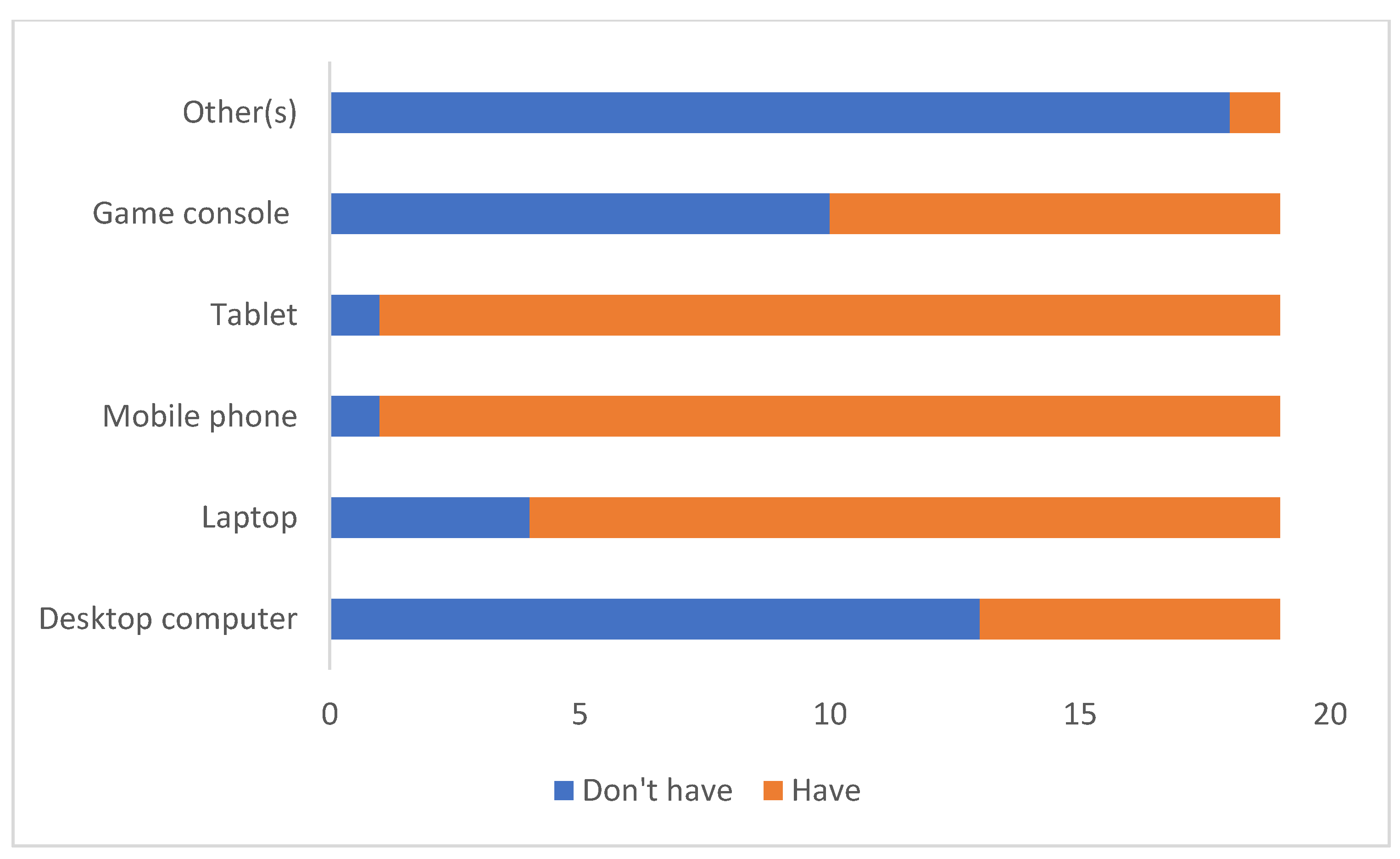
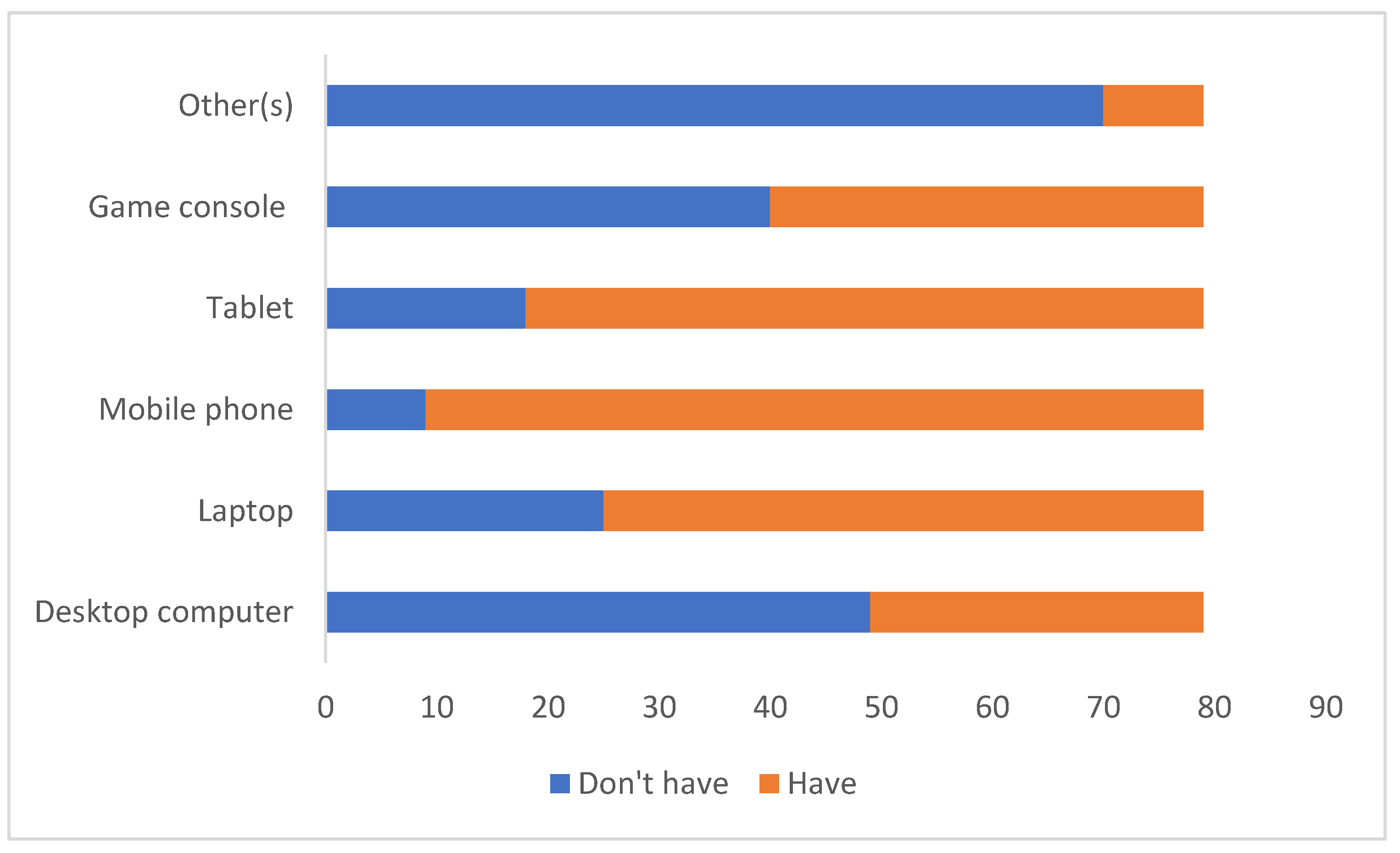
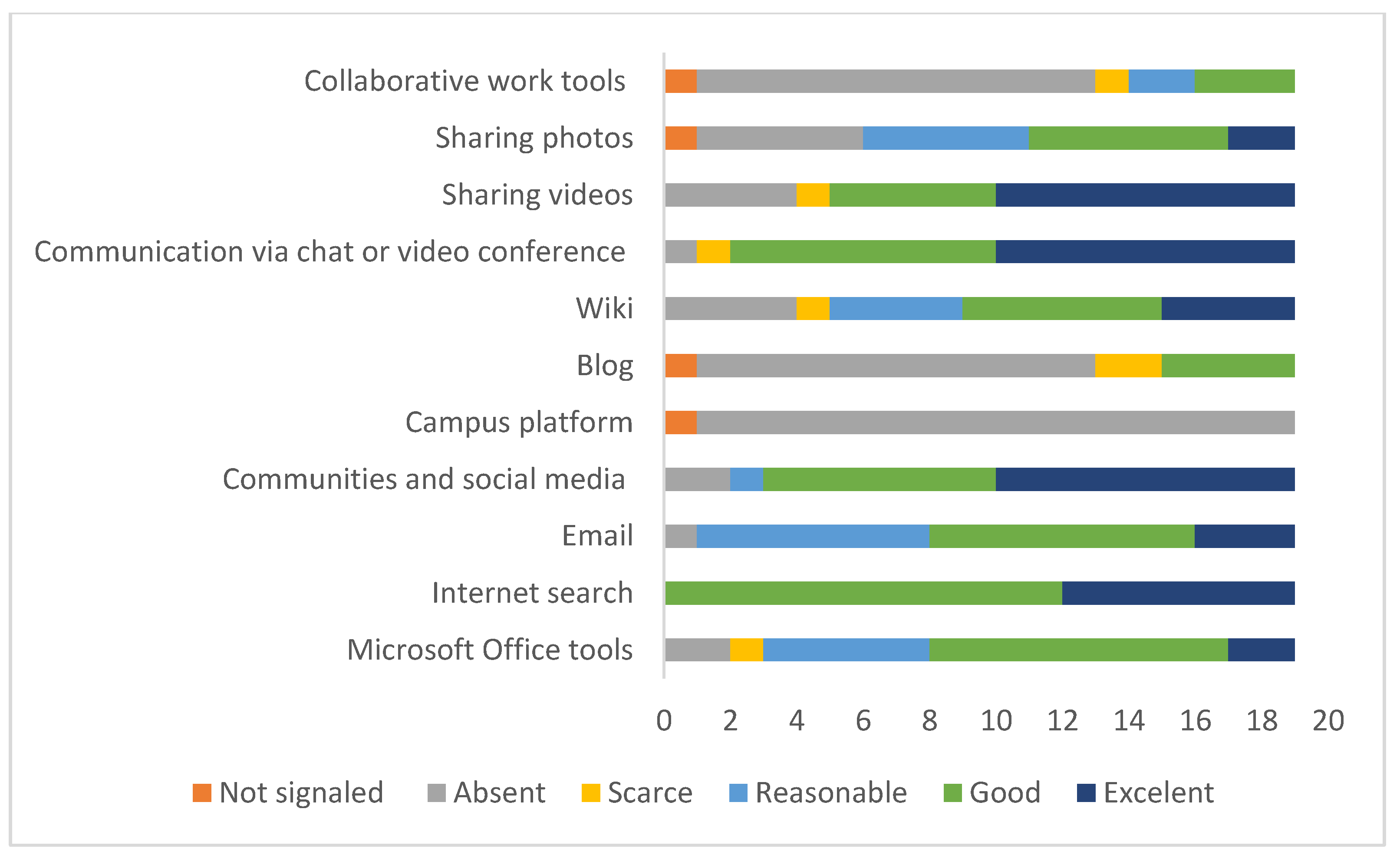
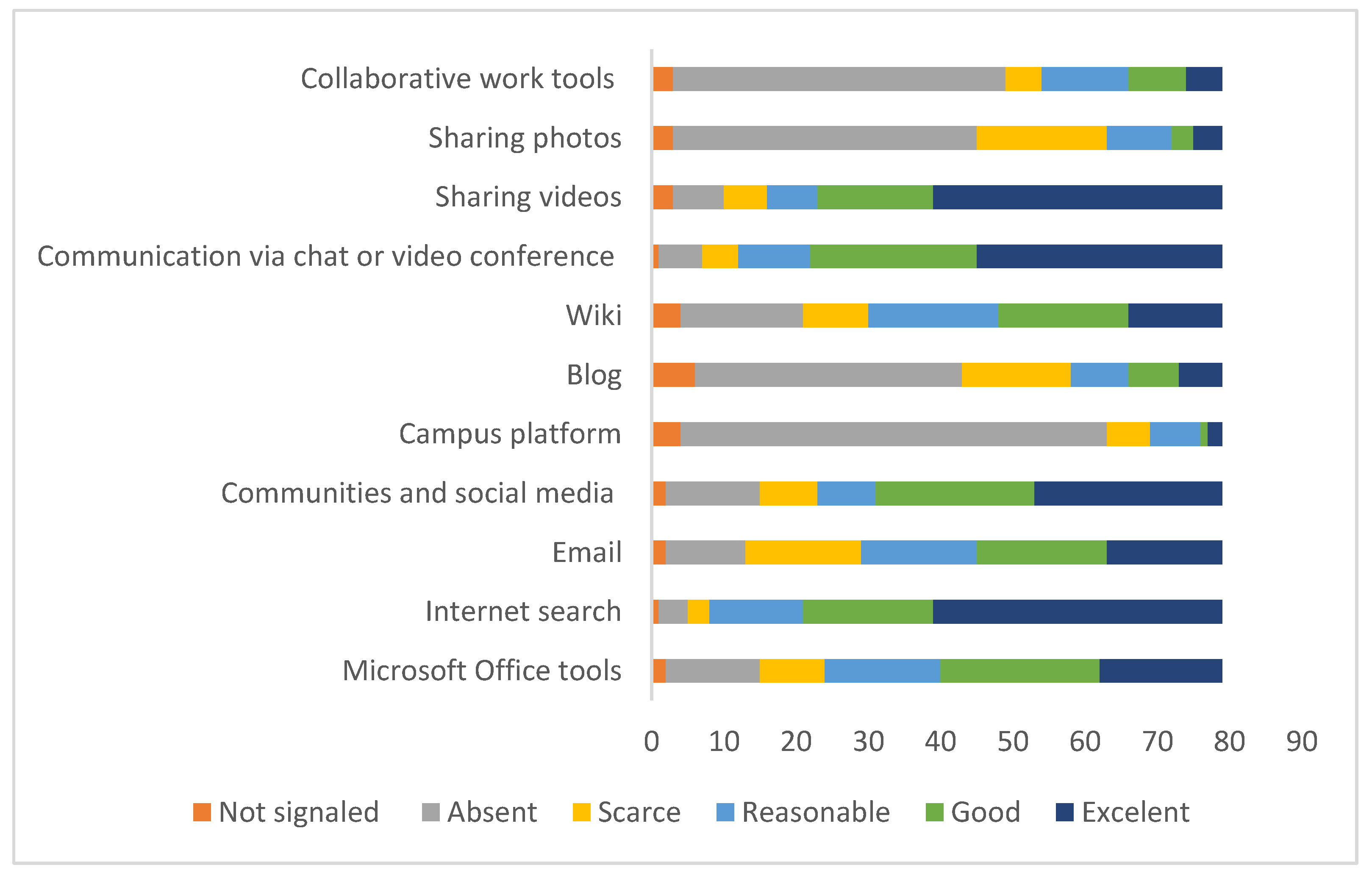
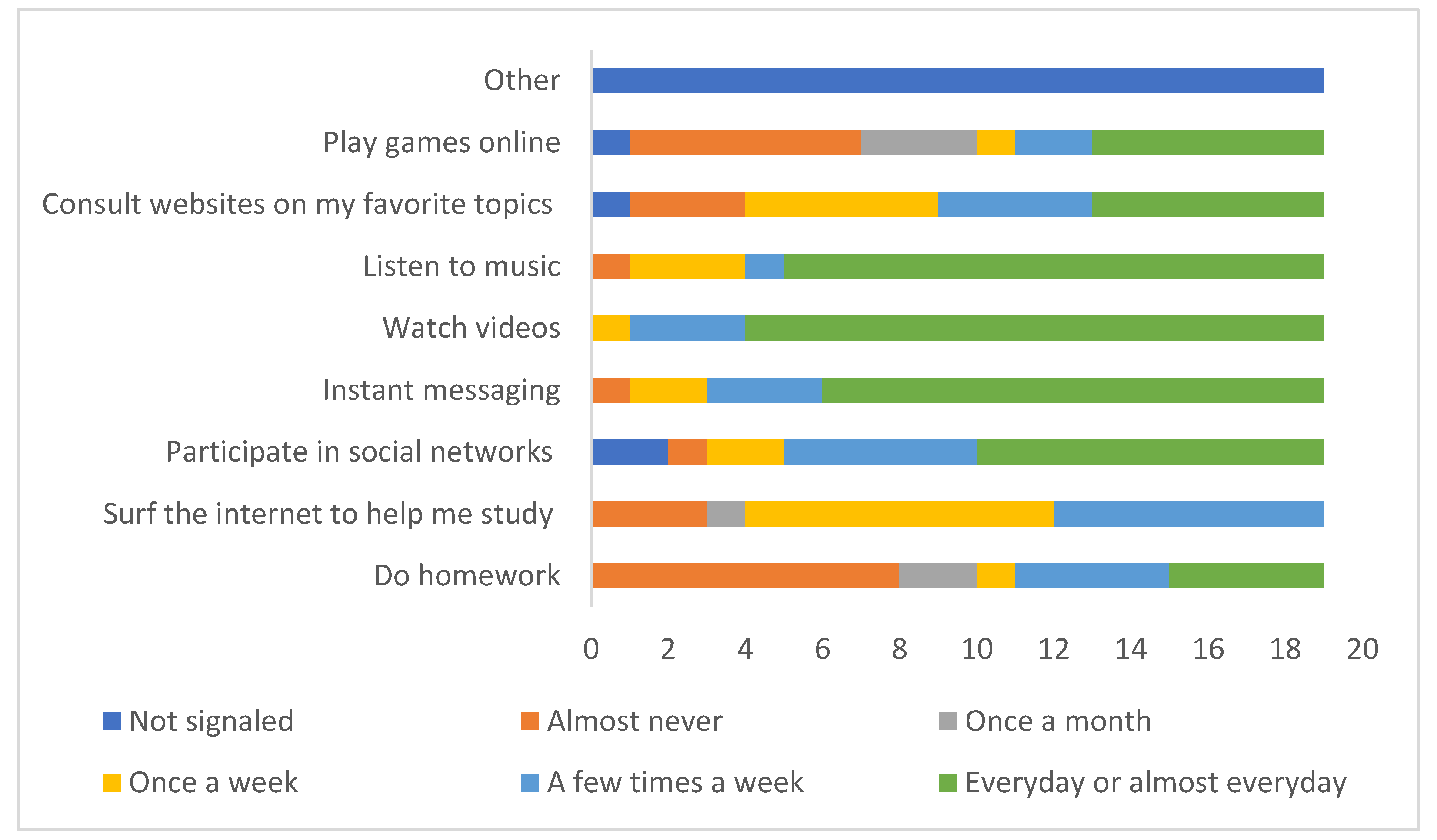

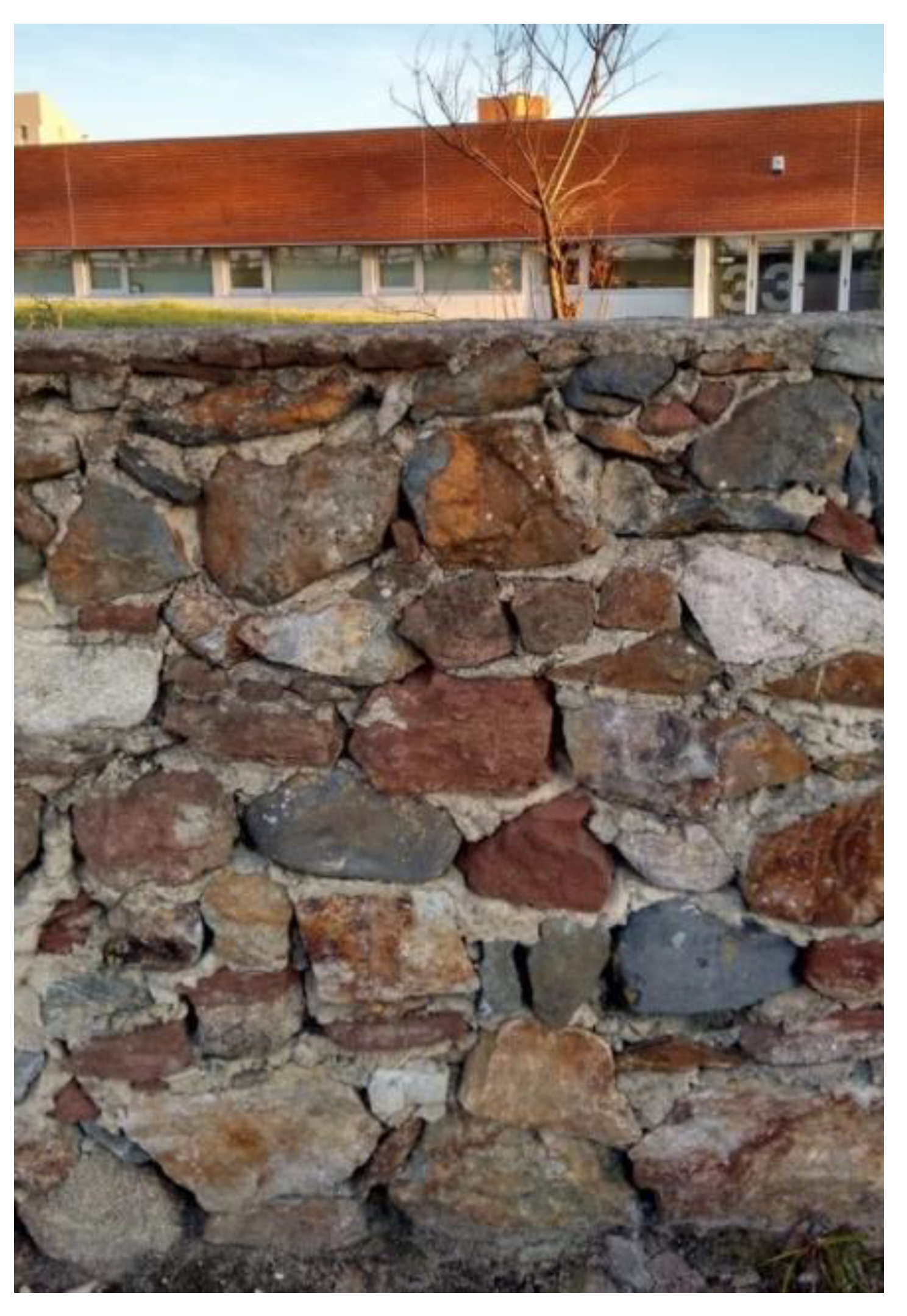

| Station(s) | Activities | Areas of Competence [51] |
|---|---|---|
| 1 and 5 | Macroscopically identify a limestone sample | Scientific, technical and technological knowledge |
| 2 | Macroscopically identify a schist sample | Scientific, technical and technological knowledge |
| 3 | Macroscopically identify a marble sample | Scientific, technical and technological knowledge |
| 4 | Macroscopically identify a basalt sample | Scientific, technical and technological knowledge |
| 6 | Macroscopically identify a granite sample | Scientific, technical and technological knowledge |
| 1, 2, 3, 4, 5 and 6 | Record observations in photo and/or video, for example, on students’ mobile phone | Information and communication |
| 1, 2, 3, 4, 5 and 6 | Record observations on the field guide | Scientific, technical and technological knowledge |
| 1, 2, 3, 4, 5 and 6 | Mark the geographic location on Google Maps or the field guide | Information and communication |
| 1, 2, 3, 4 and 5 | Decipher the clue to the geographic location of the next station | Scientific, technical and technological knowledge |
| 1, 2, 3, 4, 5 and 6 | Group work with, for example, collaboration between group members to carry out the tasks of each station | Interpersonal relationship |
| Instrument | Technique |
|---|---|
| Questionnaire on digital technologies | Descriptive statistical analysis |
| Researcher’s diary | Content analysis |
| Learning checklists | Descriptive statistical analysis Content analysis |
| Field guide (Student records on field trip guides) | Descriptive statistical analysis Content analysis |
| Final questionnaire | Descriptive statistical analysis Content analysis |
Publisher’s Note: MDPI stays neutral with regard to jurisdictional claims in published maps and institutional affiliations. |
© 2022 by the authors. Licensee MDPI, Basel, Switzerland. This article is an open access article distributed under the terms and conditions of the Creative Commons Attribution (CC BY) license (https://creativecommons.org/licenses/by/4.0/).
Share and Cite
Peixoto, E.; Pedro, L.; Vieira, R. Transmedia in Geosciences Education. Geosciences 2022, 12, 171. https://doi.org/10.3390/geosciences12040171
Peixoto E, Pedro L, Vieira R. Transmedia in Geosciences Education. Geosciences. 2022; 12(4):171. https://doi.org/10.3390/geosciences12040171
Chicago/Turabian StylePeixoto, Elisabete, Luís Pedro, and Rui Vieira. 2022. "Transmedia in Geosciences Education" Geosciences 12, no. 4: 171. https://doi.org/10.3390/geosciences12040171








